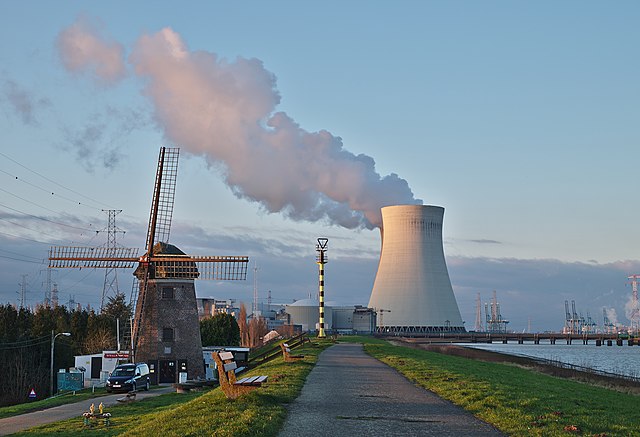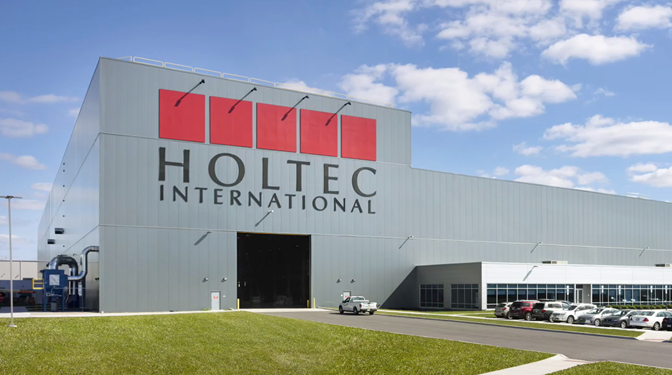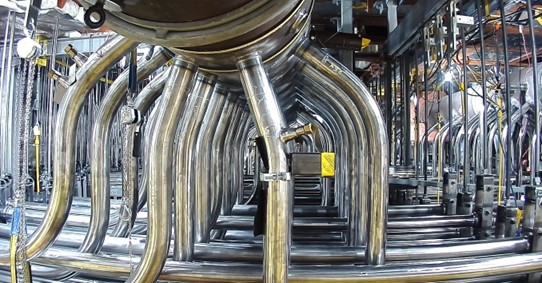An artistic rendering of the Versatile Test Reactor. (Image: DOE)
The Department of Energy today issued a Record of Decision (ROD) for the Final Versatile Test Reactor Environmental Impact Statement (final VTR EIS; DOE/EIS-0542). The VTR will be a sodium-cooled, fast-neutron-spectrum test reactor that will enhance and accelerate research, development, and demonstration of innovative nuclear energy technologies critical to tackling the climate crisis, according to the DOE.
The VTR ROD and final VTR EIS are available for viewing or download here.
The Doel nuclear power plant in Belgium along with the De Molen windmill in foreground. (Photo: Trougnouf)
The Belgian government has signed a nonbinding letter of intent with Electrabel, a subsidiary of the French utility Engie, to keep nuclear a part of Belgium’s energy mix for an additional 10 years.
Electrabel operates Belgium’s two nuclear power plants, the four-unit Doel and three-unit Tihange.
Romania’s Cernavoda Units 1 and 2. (Photo: Nuclearelectrica)
Romania’s Nuclearelectrica, the state-owned operator of the two-unit Cernavoda nuclear power plant, has awarded Candu Energy a contract to conduct design and engineering services for the facility’s Unit 1 refurbishment project, according to an announcement last week from SNC-Lavalin, Candu Energy’s parent company.
Holtec’s Advanced Manufacturing Division, in Camden, N.J. (Photo: Holtec)
The Department of Energy earlier this year approved part one of a loan application from Holtec International for small modular reactor construction and invited the firm to apply for a loan to help build four of its SMR-160 units and grow its manufacturing capacity to produce the first wave of SMRs.
A view of the entrance to tower #22, showing the dismantled part of an inclined column.
While the construction of two additional reactors at Slovakia’s Mochovce nuclear plant (Units 3 and 4) may get most of the attention, it isn’t the only major project underway there. In October of last year, plant owner Slovenské Elektrárne commenced the first phase of an effort to revitalize two of the four 125-meter-tall, Iterson-type cooling towers that serve the facility’s two operating reactors—both of which began generating electricity in the late 1990s. Towers #11 and #21 had been refurbished in 2011 and 2012, respectively. The other two, however, towers #12 and #22, had never undergone refurbishment.
Savannah River National Laboratory (Photo: DOE)
When the Department of Energy announced Innovation Network for Fusion Energy (INFUSE) awards earlier this month, Savannah River National Laboratory was named a recipient of two of the 18 awards. SRNL released a statement on July 19 explaining how a national lab with a long history of supporting environmental management and national security missions can lend a hand in the development of future commercial fusion power.
A computer-generated rendering of the Sizewell site on the Suffolk coast. Sizewell A and B are to the left and center (respectively) in this image; the section to the right is the Sizewell C area. (Image: EDF Energy)
The U.K. government has granted a development consent order (DCO) for EDF Energy’s proposed Sizewell C plant near Leiston in Suffolk, moving the new nuclear build project closer to a reality.
Nuclear New Build (NBB) Generation Company, an EDF Energy subsidiary, submitted the DCO application to the government’s Planning Inspectorate in May 2020, setting out the range of measures the project would implement to mitigate construction effects and maximize community benefits. The Planning Inspectorate accepted the application in June 2020 and completed its examination in October 2021. Recommendations were made to the secretary of state for business, energy, and industrial strategy this February.
Copernicus, TAE’s sixth-generation fusion reactor. (Image: TAE)
California-based TAE Technologies has announced that its accomplishments with its fifth-generation fusion research reactor, Norman, have allowed it to secure sufficient strategic and institutional investments to fund the construction of its sixth-generation research reactor, Copernicus.
The Bruce plant’s Unit 6 upper feeder cabinet. (Photo: Bruce Power)
As part of its “Made in Ontario” strategy announced last year, Bruce Power has awarded a contract valued at C$130 million (about US$100.8 million) to BWXT Canada in support of the ongoing major component replacement (MCR) project at the utility’s eight-unit Bruce nuclear plant.
Energy Northwest’s Columbia Generating Station, in Richland, Wash. (Photo: Energy Northwest)
Energy Northwest, owner and operator of Columbia Generating Station in Richland, Wash., recently signed a memorandum of understanding with nuclear technology firm Curio Solutions regarding Curio’s NuCycle nuclear waste recycling process.
Columbia is the Northwest’s only operating nuclear power plant, consisting of one 1,207-MWe boiling water reactor. There are currently 54 concrete and steel casks on site, holding the spent fuel produced by the reactor since it began commercial operation in 1984.
Darlington's refurbishment to be aided by Green Bond Framework funds. (Photo: OPG)
Ontario Power Generation has updated its Green Bond Framework to include nuclear energy in recognition of the role the technology stands to play in helping the company reach its decarbonization goals. (OPG’s climate change plan, established in 2020, commits the firm to achieving net-zero carbon emission status by 2040.)
The green bonds issued by the utility and its subsidiaries are used to finance and/or refinance certain energy projects and support the development of clean technologies.
A screenshot taken from a INL video demonstrating MAGNET and its digital twin. (Source: INL)
Researchers at Idaho National Laboratory (INL) recently performed their first digital twin test of the Microreactor Agile Non-nuclear Experimental Testbed (MAGNET) and captured the demonstration in a video posted July 14. The digital twin—a virtual representation of a microreactor—was built using advancements in remote monitoring, autonomous control, and predictive capabilities that could help lower operating costs of microreactor technologies and enhance their safety.
A plaque honoring JET’s world record–setting achievement of fusion energy production of 50 megajoules in a single shot (right) and commemorating a 34-year-old bet between Goldston (top left) and Jacquinot (bottom left). (Photo: PPPL and EUROfusion consortium/collage by Kiran Sudarsanan)
A wager struck by two plasma physicists 34 years ago was finally fulfilled in June during the opening day of the 48th European Physical Society Division of Plasma Physics, when Robert Goldston, former director of the Department of Energy’s Princeton Plasma Physics Laboratory (PPPL), virtually presented a plaque to his friend and colleague Jean Jacquinot, former director of the Joint European Torus (JET), EUROfusion's flagship fusion experiment based at the Culham Centre for Fusion Energy in the United Kingdom. Their bet, and JET’s record-breaking achievements in 2021, were celebrated in an article published by PPPL on July 8.
Artist's rendering of Shin-Hanul Units 3 and 4. (Image: KHNP)
South Korea’s new president, Yoon Suk-yeol, appears to be following through on his campaign pledge to reverse the previous administration’s domestic nuclear phaseout plan. Earlier this month, Yoon’s Ministry of Trade, Industry, and Energy announced a new direction for the nation’s energy policy—one that calls for, among other things, a reembrace of nuclear power. A further announcement on the subject last week provided additional details.



.jpg)

 The June 2017 special report on the ANS Nuclear Grand Challenges (available online at
The June 2017 special report on the ANS Nuclear Grand Challenges (available online at 












